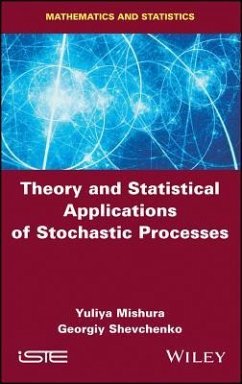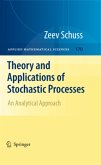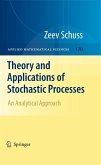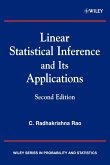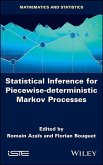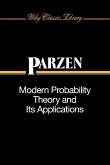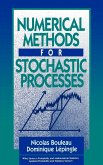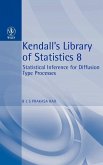- Gebundenes Buch
- Merkliste
- Auf die Merkliste
- Bewerten Bewerten
- Teilen
- Produkt teilen
- Produkterinnerung
- Produkterinnerung
This book is concerned with the theory of stochastic processes and the theoretical aspects of statistics for stochastic processes.
Andere Kunden interessierten sich auch für
![Theory and Applications of Stochastic Processes Theory and Applications of Stochastic Processes]() Zeev SchussTheory and Applications of Stochastic Processes48,99 €
Zeev SchussTheory and Applications of Stochastic Processes48,99 €![Theory and Applications of Stochastic Processes Theory and Applications of Stochastic Processes]() Zeev SchussTheory and Applications of Stochastic Processes52,99 €
Zeev SchussTheory and Applications of Stochastic Processes52,99 €![Linear Statistical Inference and Its Applications Linear Statistical Inference and Its Applications]() C Radhakrishna RaoLinear Statistical Inference and Its Applications200,99 €
C Radhakrishna RaoLinear Statistical Inference and Its Applications200,99 €![Statistical Inference for Piecewise-Deterministic Markov Processes Statistical Inference for Piecewise-Deterministic Markov Processes]() Statistical Inference for Piecewise-Deterministic Markov Processes194,99 €
Statistical Inference for Piecewise-Deterministic Markov Processes194,99 €![Modern Probability Theory and Its Applications Modern Probability Theory and Its Applications]() Emanuel ParzenModern Probability Theory and Its Applications272,99 €
Emanuel ParzenModern Probability Theory and Its Applications272,99 €![Numerical Methods for Stochastic Processes Numerical Methods for Stochastic Processes]() Nicolas BouleauNumerical Methods for Stochastic Processes280,99 €
Nicolas BouleauNumerical Methods for Stochastic Processes280,99 €![Statistical Inference for Diffusion Type Processes Statistical Inference for Diffusion Type Processes]() B L S Prakasa RaoStatistical Inference for Diffusion Type Processes151,99 €
B L S Prakasa RaoStatistical Inference for Diffusion Type Processes151,99 €-
-
-
This book is concerned with the theory of stochastic processes and the theoretical aspects of statistics for stochastic processes.
Hinweis: Dieser Artikel kann nur an eine deutsche Lieferadresse ausgeliefert werden.
Hinweis: Dieser Artikel kann nur an eine deutsche Lieferadresse ausgeliefert werden.
Produktdetails
- Produktdetails
- Verlag: Wiley
- Seitenzahl: 400
- Erscheinungstermin: 4. Januar 2018
- Englisch
- Abmessung: 236mm x 163mm x 25mm
- Gewicht: 998g
- ISBN-13: 9781786300508
- ISBN-10: 1786300508
- Artikelnr.: 47593293
- Herstellerkennzeichnung
- Produktsicherheitsverantwortliche/r
- Europaallee 1
- 36244 Bad Hersfeld
- gpsr@libri.de
- Verlag: Wiley
- Seitenzahl: 400
- Erscheinungstermin: 4. Januar 2018
- Englisch
- Abmessung: 236mm x 163mm x 25mm
- Gewicht: 998g
- ISBN-13: 9781786300508
- ISBN-10: 1786300508
- Artikelnr.: 47593293
- Herstellerkennzeichnung
- Produktsicherheitsverantwortliche/r
- Europaallee 1
- 36244 Bad Hersfeld
- gpsr@libri.de
Yuliya Mishura, National University of Kyiv, Ukraine Georgiy Shevchenko, National University of Kyiv, Ukraine
Preface xi Introduction xiii Part 1 Theory of Stochastic Processes 1 Chapter 1 Stochastic Processes General Properties. Trajectories, Finite-dimensional Distributions 3 1.1 Definition of a stochastic process 3 1.2 Trajectories of a stochastic process Some examples of stochastic processes 5 1.2.1 Definition of trajectory and some examples 5 1.2.2 Trajectory of a stochastic process as a random element.8 1.3 Finite-dimensional distributions of stochastic processes: consistency conditions.10 1.3.1 Definition and properties of finite-dimensional distributions 10 1.3.2 Consistency conditions.11 1.3.3 Cylinder sets and generated
-algebra 13 1.3.4 Kolmogorov theorem on the construction of a stochastic process by the family of probability distributions 15 1.4 Properties of
-algebra generated by cylinder sets. The notion of
-algebra generated by a stochastic process 19 Chapter 2 Stochastic Processes with Independent Increments 21 2.1 Existence of processes with independent increments in terms of incremental characteristic functions 21 2.2 Wiener process 24 2.2.1 One-dimensional Wiener process 24 2.2.2 Independent stochastic processes Multidimensional Wiener process 24 2.3 Poisson process 27 2.3.1 Poisson process defined via the existence theorem 27 2.3.2 Poisson process defined via the distributions of the increments 28 2.3.3 Poisson process as a renewal process 30 2.4 Compound Poisson process 33 2.5 Lévy processes 34 2.5.1 Wiener process with a drift 36 2.5.2 Compound Poisson process as a Lévy process 36 2.5.3 Sum of a Wiener process with a drift and a Poisson process 36 2.5.4 Gamma process 37 2.5.5 Stable Lévy motion37 2.5.6 Stable Lévy subordinator with stability parameter
(0, 1) 38 Chapter 3 Gaussian Processes Integration with Respect to Gaussian Processes 39 3.1 Gaussian vectors 39 3.2 Theorem of Gaussian representation (theorem on normal correlation) 42 3.3 Gaussian processes. 44 3.4 Examples of Gaussian processes 46 3.4.1 Wiener process as an example of a Gaussian process 46 3.4.2 Fractional Brownian motion.48 3.4.3 Sub-fractional and bi-fractional Brownian motion 50 3.4.4 Brownian bridge 50 3.4.5 Ornstein-Uhlenbeck process 51 3.5 Integration of non-random functions with respect to Gaussian processes 52 3.5.1 General approach 52 3.5.2 Integration of non-random functions with respect to the Wiener process 54 3.5.3 Integration w.r.t the fractional Brownian motion 57 3.6 Two-sided Wiener process and fractional Brownian motion: Mandelbrot-van Ness representation of fractional Brownian motion 60 3.7 Representation of fractional Brownian motion as the Wiener integral on the compact integral 63 Chapter 4 Construction, Properties and Some Functionals of the Wiener Process and Fractional Brownian Motion 67 4.1 Construction of a Wiener process on the interval [0, 1] 67 4.2 Construction of a Wiener process on R+ 72 4.3 Nowhere differentiability of the trajectories of a Wiener process 74 4.4 Power variation of the Wiener process and of the fractional Brownian motion77 4.4.1 Ergodic theorem for power variations 77 4.5 Self-similar stochastic processes 79 4.5.1 Definition of self-similarity and some examples 79 4.5.2 Power variations of self-similar processes on finite intervals.80 Chapter 5 Martingales and Related Processes 85 5.1 Notion of stochastic basis with filtration 85 5.2 Notion of (sub-, super-) martingale: elementary properties 86 5.3 Examples of (sub-, super-) martingales 87 5.4 Markov moments and stopping times 90 5.5 Martingales and related processes with discrete time 96 5.5.1 Upcrossings of the interval and existence of the limit of submartingale 96 5.5.2 Examples of martingales having a limit and of uniformly and non-uniformly integrable martingales 102 5.5.3 Lévy convergence theorem 104 5.5.4 Optional stopping 105 5.5.5 Maximal inequalities for (sub-, super-) martingales 108 5.5.6 Doob decomposition for the integrable processes with discrete time 111 5.5.7 Quadratic variation and quadratic characteristics: Burkholder-Davis-Gundy inequalities 113 5.5.8 Change of probability measure and Girsanov theorem for discrete-time processes 116 5.5.9 Strong law of large numbers for martingales with discrete time 120 5.6 Lévy martingale stopped 126 5.7 Martingales with continuous time 127 Chapter 6 Regularity of Trajectories of Stochastic Processes 131 6.1 Continuity in probability and in L2(
,F, P) 131 6.2 Modification of stochastic processes: stochastically equivalent and indistinguishable processes 133 6.3 Separable stochastic processes: existence of separable modification 135 6.4 Conditions of D-regularity and absence of the discontinuities of the second kind for stochastic processes 138 6.4.1 Skorokhod conditions of D-regularity in terms of three-dimensional distributions 138 6.4.2 Conditions of absence of the discontinuities of the second kind formulated in terms of conditional probabilities of large increments 144 6.5 Conditions of continuity of trajectories of stochastic processes 148 6.5.1 Kolmogorov conditions of continuity in terms of two-dimensional distributions 148 6.5.2 Hölder continuity of stochastic processes: a sufficient condition 152 6.5.3 Conditions of continuity in terms of conditional probabilities 154 Chapter 7 Markov and Diffusion Processes 157 7.1 Markov property 157 7.2 Examples of Markov processes 163 7.2.1 Discrete-time Markov chain 163 7.2.2 Continuous-time Markov chain 165 7.2.3 Process with independent increments 168 7.3 Semigroup resolvent operator and generator related to the homogeneous Markov process 168 7.3.1 Semigroup related to Markov process 168 7.3.2 Resolvent operator and resolvent equation 169 7.3.3 Generator of a semigroup.171 7.4 Definition and basic properties of diffusion process 175 7.5 Homogeneous diffusion process Wiener process as a diffusion process 179 7.6 Kolmogorov equations for diffusions 181 Chapter 8 Stochastic Integration 187 8.1 Motivation..187 8.2 Definition of Itô integral 189 8.2.1 Itô integral of Wiener process 195 8.3 Continuity of Itô integral 197 8.4 Extended Itô integral 199 8.5 Itô processes and Itô formula 203 8.6 Multivariate stochastic calculus 212 8.7 Maximal inequalities for Itô martingales 215 8.7.1 Strong law of large numbers for Itô local martingales 218 8.8 Lévy martingale characterization of Wiener process 220 8.9 Girsanov theorem 223 8.10 Itô representation 228 Chapter 9 Stochastic Differential Equations.233 9.1 Definition, solvability conditions, examples 233 9.1.1 Existence and uniqueness of solution 234 9.1.2 Some special stochastic differential equations 238 9.2 Properties of solutions to stochastic differential equations 241 9.3 Continuous dependence of solutions on coefficients 245 9.4 Weak solutions to stochastic differential equations. 247 9.5 Solutions to SDEs as diffusion processe 249 9.6 Viability, comparison and positivity of solutions to stochastic differential equations 252 9.6.1 Comparison theorem for one-dimensional projections of stochastic differential equations 257 9.6.2 Non-negativity of solutions to stochastic differential equations 258 9.7 Feynman-Kac formula 258 9.8 Diffusion model of financial markets 260 9.8.1 Admissible portfolios, arbitrage and equivalent martingale measure 263 9.8.2 Contingent claims, pricing and hedging 266 Part 2 Statistics of Stochastic Processes 271 Chapter 10 Parameter Estimation 273 10.1 Drift and diffusion parameter estimation in the linear regression model with discrete time 273 10.1.1 Drift estimation in the linear regression model with discrete time in the case when the initial value is known 274 10.1.2 Drift estimation in the case when the initial value is unknown 277 10.2 Estimation of the diffusion coefficient in a linear regression model with discrete time 277 10.3 Drift and diffusion parameter estimation in the linear model with continuous time and the Wiener noise 278 10.3.1 Drift parameter estimation 279 10.3.2 Diffusion parameter estimation 280 10.4 Parameter estimation in linear models with fractional Brownian motion 281 10.4.1 Estimation of Hurst index 281 10.4.2 Estimation of the diffusion parameter 283 10.5 Drift parameter estimation 284 10.6 Drift parameter estimation in the simplest autoregressive model 285 10.7 Drift parameters estimation in the homogeneous diffusion model 289 Chapter 11 Filtering Problem Kalman-Bucy Filter 293 11.1 General setting 293 11.2 Auxiliary properties of the non-observable process 294 11.3 What is an optimal filter 295 11.4 Representation of an optimal filter via an integral equation with respect to an observable process 296 11.5 Integral Wiener-Hopf equation 299 Appendices 311 Appendix 1 313 Appendix 2 329 Bibliography 363 Index 369
-algebra 13 1.3.4 Kolmogorov theorem on the construction of a stochastic process by the family of probability distributions 15 1.4 Properties of
-algebra generated by cylinder sets. The notion of
-algebra generated by a stochastic process 19 Chapter 2 Stochastic Processes with Independent Increments 21 2.1 Existence of processes with independent increments in terms of incremental characteristic functions 21 2.2 Wiener process 24 2.2.1 One-dimensional Wiener process 24 2.2.2 Independent stochastic processes Multidimensional Wiener process 24 2.3 Poisson process 27 2.3.1 Poisson process defined via the existence theorem 27 2.3.2 Poisson process defined via the distributions of the increments 28 2.3.3 Poisson process as a renewal process 30 2.4 Compound Poisson process 33 2.5 Lévy processes 34 2.5.1 Wiener process with a drift 36 2.5.2 Compound Poisson process as a Lévy process 36 2.5.3 Sum of a Wiener process with a drift and a Poisson process 36 2.5.4 Gamma process 37 2.5.5 Stable Lévy motion37 2.5.6 Stable Lévy subordinator with stability parameter
(0, 1) 38 Chapter 3 Gaussian Processes Integration with Respect to Gaussian Processes 39 3.1 Gaussian vectors 39 3.2 Theorem of Gaussian representation (theorem on normal correlation) 42 3.3 Gaussian processes. 44 3.4 Examples of Gaussian processes 46 3.4.1 Wiener process as an example of a Gaussian process 46 3.4.2 Fractional Brownian motion.48 3.4.3 Sub-fractional and bi-fractional Brownian motion 50 3.4.4 Brownian bridge 50 3.4.5 Ornstein-Uhlenbeck process 51 3.5 Integration of non-random functions with respect to Gaussian processes 52 3.5.1 General approach 52 3.5.2 Integration of non-random functions with respect to the Wiener process 54 3.5.3 Integration w.r.t the fractional Brownian motion 57 3.6 Two-sided Wiener process and fractional Brownian motion: Mandelbrot-van Ness representation of fractional Brownian motion 60 3.7 Representation of fractional Brownian motion as the Wiener integral on the compact integral 63 Chapter 4 Construction, Properties and Some Functionals of the Wiener Process and Fractional Brownian Motion 67 4.1 Construction of a Wiener process on the interval [0, 1] 67 4.2 Construction of a Wiener process on R+ 72 4.3 Nowhere differentiability of the trajectories of a Wiener process 74 4.4 Power variation of the Wiener process and of the fractional Brownian motion77 4.4.1 Ergodic theorem for power variations 77 4.5 Self-similar stochastic processes 79 4.5.1 Definition of self-similarity and some examples 79 4.5.2 Power variations of self-similar processes on finite intervals.80 Chapter 5 Martingales and Related Processes 85 5.1 Notion of stochastic basis with filtration 85 5.2 Notion of (sub-, super-) martingale: elementary properties 86 5.3 Examples of (sub-, super-) martingales 87 5.4 Markov moments and stopping times 90 5.5 Martingales and related processes with discrete time 96 5.5.1 Upcrossings of the interval and existence of the limit of submartingale 96 5.5.2 Examples of martingales having a limit and of uniformly and non-uniformly integrable martingales 102 5.5.3 Lévy convergence theorem 104 5.5.4 Optional stopping 105 5.5.5 Maximal inequalities for (sub-, super-) martingales 108 5.5.6 Doob decomposition for the integrable processes with discrete time 111 5.5.7 Quadratic variation and quadratic characteristics: Burkholder-Davis-Gundy inequalities 113 5.5.8 Change of probability measure and Girsanov theorem for discrete-time processes 116 5.5.9 Strong law of large numbers for martingales with discrete time 120 5.6 Lévy martingale stopped 126 5.7 Martingales with continuous time 127 Chapter 6 Regularity of Trajectories of Stochastic Processes 131 6.1 Continuity in probability and in L2(
,F, P) 131 6.2 Modification of stochastic processes: stochastically equivalent and indistinguishable processes 133 6.3 Separable stochastic processes: existence of separable modification 135 6.4 Conditions of D-regularity and absence of the discontinuities of the second kind for stochastic processes 138 6.4.1 Skorokhod conditions of D-regularity in terms of three-dimensional distributions 138 6.4.2 Conditions of absence of the discontinuities of the second kind formulated in terms of conditional probabilities of large increments 144 6.5 Conditions of continuity of trajectories of stochastic processes 148 6.5.1 Kolmogorov conditions of continuity in terms of two-dimensional distributions 148 6.5.2 Hölder continuity of stochastic processes: a sufficient condition 152 6.5.3 Conditions of continuity in terms of conditional probabilities 154 Chapter 7 Markov and Diffusion Processes 157 7.1 Markov property 157 7.2 Examples of Markov processes 163 7.2.1 Discrete-time Markov chain 163 7.2.2 Continuous-time Markov chain 165 7.2.3 Process with independent increments 168 7.3 Semigroup resolvent operator and generator related to the homogeneous Markov process 168 7.3.1 Semigroup related to Markov process 168 7.3.2 Resolvent operator and resolvent equation 169 7.3.3 Generator of a semigroup.171 7.4 Definition and basic properties of diffusion process 175 7.5 Homogeneous diffusion process Wiener process as a diffusion process 179 7.6 Kolmogorov equations for diffusions 181 Chapter 8 Stochastic Integration 187 8.1 Motivation..187 8.2 Definition of Itô integral 189 8.2.1 Itô integral of Wiener process 195 8.3 Continuity of Itô integral 197 8.4 Extended Itô integral 199 8.5 Itô processes and Itô formula 203 8.6 Multivariate stochastic calculus 212 8.7 Maximal inequalities for Itô martingales 215 8.7.1 Strong law of large numbers for Itô local martingales 218 8.8 Lévy martingale characterization of Wiener process 220 8.9 Girsanov theorem 223 8.10 Itô representation 228 Chapter 9 Stochastic Differential Equations.233 9.1 Definition, solvability conditions, examples 233 9.1.1 Existence and uniqueness of solution 234 9.1.2 Some special stochastic differential equations 238 9.2 Properties of solutions to stochastic differential equations 241 9.3 Continuous dependence of solutions on coefficients 245 9.4 Weak solutions to stochastic differential equations. 247 9.5 Solutions to SDEs as diffusion processe 249 9.6 Viability, comparison and positivity of solutions to stochastic differential equations 252 9.6.1 Comparison theorem for one-dimensional projections of stochastic differential equations 257 9.6.2 Non-negativity of solutions to stochastic differential equations 258 9.7 Feynman-Kac formula 258 9.8 Diffusion model of financial markets 260 9.8.1 Admissible portfolios, arbitrage and equivalent martingale measure 263 9.8.2 Contingent claims, pricing and hedging 266 Part 2 Statistics of Stochastic Processes 271 Chapter 10 Parameter Estimation 273 10.1 Drift and diffusion parameter estimation in the linear regression model with discrete time 273 10.1.1 Drift estimation in the linear regression model with discrete time in the case when the initial value is known 274 10.1.2 Drift estimation in the case when the initial value is unknown 277 10.2 Estimation of the diffusion coefficient in a linear regression model with discrete time 277 10.3 Drift and diffusion parameter estimation in the linear model with continuous time and the Wiener noise 278 10.3.1 Drift parameter estimation 279 10.3.2 Diffusion parameter estimation 280 10.4 Parameter estimation in linear models with fractional Brownian motion 281 10.4.1 Estimation of Hurst index 281 10.4.2 Estimation of the diffusion parameter 283 10.5 Drift parameter estimation 284 10.6 Drift parameter estimation in the simplest autoregressive model 285 10.7 Drift parameters estimation in the homogeneous diffusion model 289 Chapter 11 Filtering Problem Kalman-Bucy Filter 293 11.1 General setting 293 11.2 Auxiliary properties of the non-observable process 294 11.3 What is an optimal filter 295 11.4 Representation of an optimal filter via an integral equation with respect to an observable process 296 11.5 Integral Wiener-Hopf equation 299 Appendices 311 Appendix 1 313 Appendix 2 329 Bibliography 363 Index 369
Preface xi Introduction xiii Part 1 Theory of Stochastic Processes 1 Chapter 1 Stochastic Processes General Properties. Trajectories, Finite-dimensional Distributions 3 1.1 Definition of a stochastic process 3 1.2 Trajectories of a stochastic process Some examples of stochastic processes 5 1.2.1 Definition of trajectory and some examples 5 1.2.2 Trajectory of a stochastic process as a random element.8 1.3 Finite-dimensional distributions of stochastic processes: consistency conditions.10 1.3.1 Definition and properties of finite-dimensional distributions 10 1.3.2 Consistency conditions.11 1.3.3 Cylinder sets and generated
-algebra 13 1.3.4 Kolmogorov theorem on the construction of a stochastic process by the family of probability distributions 15 1.4 Properties of
-algebra generated by cylinder sets. The notion of
-algebra generated by a stochastic process 19 Chapter 2 Stochastic Processes with Independent Increments 21 2.1 Existence of processes with independent increments in terms of incremental characteristic functions 21 2.2 Wiener process 24 2.2.1 One-dimensional Wiener process 24 2.2.2 Independent stochastic processes Multidimensional Wiener process 24 2.3 Poisson process 27 2.3.1 Poisson process defined via the existence theorem 27 2.3.2 Poisson process defined via the distributions of the increments 28 2.3.3 Poisson process as a renewal process 30 2.4 Compound Poisson process 33 2.5 Lévy processes 34 2.5.1 Wiener process with a drift 36 2.5.2 Compound Poisson process as a Lévy process 36 2.5.3 Sum of a Wiener process with a drift and a Poisson process 36 2.5.4 Gamma process 37 2.5.5 Stable Lévy motion37 2.5.6 Stable Lévy subordinator with stability parameter
(0, 1) 38 Chapter 3 Gaussian Processes Integration with Respect to Gaussian Processes 39 3.1 Gaussian vectors 39 3.2 Theorem of Gaussian representation (theorem on normal correlation) 42 3.3 Gaussian processes. 44 3.4 Examples of Gaussian processes 46 3.4.1 Wiener process as an example of a Gaussian process 46 3.4.2 Fractional Brownian motion.48 3.4.3 Sub-fractional and bi-fractional Brownian motion 50 3.4.4 Brownian bridge 50 3.4.5 Ornstein-Uhlenbeck process 51 3.5 Integration of non-random functions with respect to Gaussian processes 52 3.5.1 General approach 52 3.5.2 Integration of non-random functions with respect to the Wiener process 54 3.5.3 Integration w.r.t the fractional Brownian motion 57 3.6 Two-sided Wiener process and fractional Brownian motion: Mandelbrot-van Ness representation of fractional Brownian motion 60 3.7 Representation of fractional Brownian motion as the Wiener integral on the compact integral 63 Chapter 4 Construction, Properties and Some Functionals of the Wiener Process and Fractional Brownian Motion 67 4.1 Construction of a Wiener process on the interval [0, 1] 67 4.2 Construction of a Wiener process on R+ 72 4.3 Nowhere differentiability of the trajectories of a Wiener process 74 4.4 Power variation of the Wiener process and of the fractional Brownian motion77 4.4.1 Ergodic theorem for power variations 77 4.5 Self-similar stochastic processes 79 4.5.1 Definition of self-similarity and some examples 79 4.5.2 Power variations of self-similar processes on finite intervals.80 Chapter 5 Martingales and Related Processes 85 5.1 Notion of stochastic basis with filtration 85 5.2 Notion of (sub-, super-) martingale: elementary properties 86 5.3 Examples of (sub-, super-) martingales 87 5.4 Markov moments and stopping times 90 5.5 Martingales and related processes with discrete time 96 5.5.1 Upcrossings of the interval and existence of the limit of submartingale 96 5.5.2 Examples of martingales having a limit and of uniformly and non-uniformly integrable martingales 102 5.5.3 Lévy convergence theorem 104 5.5.4 Optional stopping 105 5.5.5 Maximal inequalities for (sub-, super-) martingales 108 5.5.6 Doob decomposition for the integrable processes with discrete time 111 5.5.7 Quadratic variation and quadratic characteristics: Burkholder-Davis-Gundy inequalities 113 5.5.8 Change of probability measure and Girsanov theorem for discrete-time processes 116 5.5.9 Strong law of large numbers for martingales with discrete time 120 5.6 Lévy martingale stopped 126 5.7 Martingales with continuous time 127 Chapter 6 Regularity of Trajectories of Stochastic Processes 131 6.1 Continuity in probability and in L2(
,F, P) 131 6.2 Modification of stochastic processes: stochastically equivalent and indistinguishable processes 133 6.3 Separable stochastic processes: existence of separable modification 135 6.4 Conditions of D-regularity and absence of the discontinuities of the second kind for stochastic processes 138 6.4.1 Skorokhod conditions of D-regularity in terms of three-dimensional distributions 138 6.4.2 Conditions of absence of the discontinuities of the second kind formulated in terms of conditional probabilities of large increments 144 6.5 Conditions of continuity of trajectories of stochastic processes 148 6.5.1 Kolmogorov conditions of continuity in terms of two-dimensional distributions 148 6.5.2 Hölder continuity of stochastic processes: a sufficient condition 152 6.5.3 Conditions of continuity in terms of conditional probabilities 154 Chapter 7 Markov and Diffusion Processes 157 7.1 Markov property 157 7.2 Examples of Markov processes 163 7.2.1 Discrete-time Markov chain 163 7.2.2 Continuous-time Markov chain 165 7.2.3 Process with independent increments 168 7.3 Semigroup resolvent operator and generator related to the homogeneous Markov process 168 7.3.1 Semigroup related to Markov process 168 7.3.2 Resolvent operator and resolvent equation 169 7.3.3 Generator of a semigroup.171 7.4 Definition and basic properties of diffusion process 175 7.5 Homogeneous diffusion process Wiener process as a diffusion process 179 7.6 Kolmogorov equations for diffusions 181 Chapter 8 Stochastic Integration 187 8.1 Motivation..187 8.2 Definition of Itô integral 189 8.2.1 Itô integral of Wiener process 195 8.3 Continuity of Itô integral 197 8.4 Extended Itô integral 199 8.5 Itô processes and Itô formula 203 8.6 Multivariate stochastic calculus 212 8.7 Maximal inequalities for Itô martingales 215 8.7.1 Strong law of large numbers for Itô local martingales 218 8.8 Lévy martingale characterization of Wiener process 220 8.9 Girsanov theorem 223 8.10 Itô representation 228 Chapter 9 Stochastic Differential Equations.233 9.1 Definition, solvability conditions, examples 233 9.1.1 Existence and uniqueness of solution 234 9.1.2 Some special stochastic differential equations 238 9.2 Properties of solutions to stochastic differential equations 241 9.3 Continuous dependence of solutions on coefficients 245 9.4 Weak solutions to stochastic differential equations. 247 9.5 Solutions to SDEs as diffusion processe 249 9.6 Viability, comparison and positivity of solutions to stochastic differential equations 252 9.6.1 Comparison theorem for one-dimensional projections of stochastic differential equations 257 9.6.2 Non-negativity of solutions to stochastic differential equations 258 9.7 Feynman-Kac formula 258 9.8 Diffusion model of financial markets 260 9.8.1 Admissible portfolios, arbitrage and equivalent martingale measure 263 9.8.2 Contingent claims, pricing and hedging 266 Part 2 Statistics of Stochastic Processes 271 Chapter 10 Parameter Estimation 273 10.1 Drift and diffusion parameter estimation in the linear regression model with discrete time 273 10.1.1 Drift estimation in the linear regression model with discrete time in the case when the initial value is known 274 10.1.2 Drift estimation in the case when the initial value is unknown 277 10.2 Estimation of the diffusion coefficient in a linear regression model with discrete time 277 10.3 Drift and diffusion parameter estimation in the linear model with continuous time and the Wiener noise 278 10.3.1 Drift parameter estimation 279 10.3.2 Diffusion parameter estimation 280 10.4 Parameter estimation in linear models with fractional Brownian motion 281 10.4.1 Estimation of Hurst index 281 10.4.2 Estimation of the diffusion parameter 283 10.5 Drift parameter estimation 284 10.6 Drift parameter estimation in the simplest autoregressive model 285 10.7 Drift parameters estimation in the homogeneous diffusion model 289 Chapter 11 Filtering Problem Kalman-Bucy Filter 293 11.1 General setting 293 11.2 Auxiliary properties of the non-observable process 294 11.3 What is an optimal filter 295 11.4 Representation of an optimal filter via an integral equation with respect to an observable process 296 11.5 Integral Wiener-Hopf equation 299 Appendices 311 Appendix 1 313 Appendix 2 329 Bibliography 363 Index 369
-algebra 13 1.3.4 Kolmogorov theorem on the construction of a stochastic process by the family of probability distributions 15 1.4 Properties of
-algebra generated by cylinder sets. The notion of
-algebra generated by a stochastic process 19 Chapter 2 Stochastic Processes with Independent Increments 21 2.1 Existence of processes with independent increments in terms of incremental characteristic functions 21 2.2 Wiener process 24 2.2.1 One-dimensional Wiener process 24 2.2.2 Independent stochastic processes Multidimensional Wiener process 24 2.3 Poisson process 27 2.3.1 Poisson process defined via the existence theorem 27 2.3.2 Poisson process defined via the distributions of the increments 28 2.3.3 Poisson process as a renewal process 30 2.4 Compound Poisson process 33 2.5 Lévy processes 34 2.5.1 Wiener process with a drift 36 2.5.2 Compound Poisson process as a Lévy process 36 2.5.3 Sum of a Wiener process with a drift and a Poisson process 36 2.5.4 Gamma process 37 2.5.5 Stable Lévy motion37 2.5.6 Stable Lévy subordinator with stability parameter
(0, 1) 38 Chapter 3 Gaussian Processes Integration with Respect to Gaussian Processes 39 3.1 Gaussian vectors 39 3.2 Theorem of Gaussian representation (theorem on normal correlation) 42 3.3 Gaussian processes. 44 3.4 Examples of Gaussian processes 46 3.4.1 Wiener process as an example of a Gaussian process 46 3.4.2 Fractional Brownian motion.48 3.4.3 Sub-fractional and bi-fractional Brownian motion 50 3.4.4 Brownian bridge 50 3.4.5 Ornstein-Uhlenbeck process 51 3.5 Integration of non-random functions with respect to Gaussian processes 52 3.5.1 General approach 52 3.5.2 Integration of non-random functions with respect to the Wiener process 54 3.5.3 Integration w.r.t the fractional Brownian motion 57 3.6 Two-sided Wiener process and fractional Brownian motion: Mandelbrot-van Ness representation of fractional Brownian motion 60 3.7 Representation of fractional Brownian motion as the Wiener integral on the compact integral 63 Chapter 4 Construction, Properties and Some Functionals of the Wiener Process and Fractional Brownian Motion 67 4.1 Construction of a Wiener process on the interval [0, 1] 67 4.2 Construction of a Wiener process on R+ 72 4.3 Nowhere differentiability of the trajectories of a Wiener process 74 4.4 Power variation of the Wiener process and of the fractional Brownian motion77 4.4.1 Ergodic theorem for power variations 77 4.5 Self-similar stochastic processes 79 4.5.1 Definition of self-similarity and some examples 79 4.5.2 Power variations of self-similar processes on finite intervals.80 Chapter 5 Martingales and Related Processes 85 5.1 Notion of stochastic basis with filtration 85 5.2 Notion of (sub-, super-) martingale: elementary properties 86 5.3 Examples of (sub-, super-) martingales 87 5.4 Markov moments and stopping times 90 5.5 Martingales and related processes with discrete time 96 5.5.1 Upcrossings of the interval and existence of the limit of submartingale 96 5.5.2 Examples of martingales having a limit and of uniformly and non-uniformly integrable martingales 102 5.5.3 Lévy convergence theorem 104 5.5.4 Optional stopping 105 5.5.5 Maximal inequalities for (sub-, super-) martingales 108 5.5.6 Doob decomposition for the integrable processes with discrete time 111 5.5.7 Quadratic variation and quadratic characteristics: Burkholder-Davis-Gundy inequalities 113 5.5.8 Change of probability measure and Girsanov theorem for discrete-time processes 116 5.5.9 Strong law of large numbers for martingales with discrete time 120 5.6 Lévy martingale stopped 126 5.7 Martingales with continuous time 127 Chapter 6 Regularity of Trajectories of Stochastic Processes 131 6.1 Continuity in probability and in L2(
,F, P) 131 6.2 Modification of stochastic processes: stochastically equivalent and indistinguishable processes 133 6.3 Separable stochastic processes: existence of separable modification 135 6.4 Conditions of D-regularity and absence of the discontinuities of the second kind for stochastic processes 138 6.4.1 Skorokhod conditions of D-regularity in terms of three-dimensional distributions 138 6.4.2 Conditions of absence of the discontinuities of the second kind formulated in terms of conditional probabilities of large increments 144 6.5 Conditions of continuity of trajectories of stochastic processes 148 6.5.1 Kolmogorov conditions of continuity in terms of two-dimensional distributions 148 6.5.2 Hölder continuity of stochastic processes: a sufficient condition 152 6.5.3 Conditions of continuity in terms of conditional probabilities 154 Chapter 7 Markov and Diffusion Processes 157 7.1 Markov property 157 7.2 Examples of Markov processes 163 7.2.1 Discrete-time Markov chain 163 7.2.2 Continuous-time Markov chain 165 7.2.3 Process with independent increments 168 7.3 Semigroup resolvent operator and generator related to the homogeneous Markov process 168 7.3.1 Semigroup related to Markov process 168 7.3.2 Resolvent operator and resolvent equation 169 7.3.3 Generator of a semigroup.171 7.4 Definition and basic properties of diffusion process 175 7.5 Homogeneous diffusion process Wiener process as a diffusion process 179 7.6 Kolmogorov equations for diffusions 181 Chapter 8 Stochastic Integration 187 8.1 Motivation..187 8.2 Definition of Itô integral 189 8.2.1 Itô integral of Wiener process 195 8.3 Continuity of Itô integral 197 8.4 Extended Itô integral 199 8.5 Itô processes and Itô formula 203 8.6 Multivariate stochastic calculus 212 8.7 Maximal inequalities for Itô martingales 215 8.7.1 Strong law of large numbers for Itô local martingales 218 8.8 Lévy martingale characterization of Wiener process 220 8.9 Girsanov theorem 223 8.10 Itô representation 228 Chapter 9 Stochastic Differential Equations.233 9.1 Definition, solvability conditions, examples 233 9.1.1 Existence and uniqueness of solution 234 9.1.2 Some special stochastic differential equations 238 9.2 Properties of solutions to stochastic differential equations 241 9.3 Continuous dependence of solutions on coefficients 245 9.4 Weak solutions to stochastic differential equations. 247 9.5 Solutions to SDEs as diffusion processe 249 9.6 Viability, comparison and positivity of solutions to stochastic differential equations 252 9.6.1 Comparison theorem for one-dimensional projections of stochastic differential equations 257 9.6.2 Non-negativity of solutions to stochastic differential equations 258 9.7 Feynman-Kac formula 258 9.8 Diffusion model of financial markets 260 9.8.1 Admissible portfolios, arbitrage and equivalent martingale measure 263 9.8.2 Contingent claims, pricing and hedging 266 Part 2 Statistics of Stochastic Processes 271 Chapter 10 Parameter Estimation 273 10.1 Drift and diffusion parameter estimation in the linear regression model with discrete time 273 10.1.1 Drift estimation in the linear regression model with discrete time in the case when the initial value is known 274 10.1.2 Drift estimation in the case when the initial value is unknown 277 10.2 Estimation of the diffusion coefficient in a linear regression model with discrete time 277 10.3 Drift and diffusion parameter estimation in the linear model with continuous time and the Wiener noise 278 10.3.1 Drift parameter estimation 279 10.3.2 Diffusion parameter estimation 280 10.4 Parameter estimation in linear models with fractional Brownian motion 281 10.4.1 Estimation of Hurst index 281 10.4.2 Estimation of the diffusion parameter 283 10.5 Drift parameter estimation 284 10.6 Drift parameter estimation in the simplest autoregressive model 285 10.7 Drift parameters estimation in the homogeneous diffusion model 289 Chapter 11 Filtering Problem Kalman-Bucy Filter 293 11.1 General setting 293 11.2 Auxiliary properties of the non-observable process 294 11.3 What is an optimal filter 295 11.4 Representation of an optimal filter via an integral equation with respect to an observable process 296 11.5 Integral Wiener-Hopf equation 299 Appendices 311 Appendix 1 313 Appendix 2 329 Bibliography 363 Index 369

